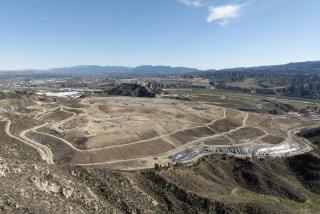Landfills Being Recycled as Recreation Centers
- Share via
Just another hard-hat Monday on Strathern Street in Sun Valley.
Scrap-yard machines moan in the dreary haze. A big rig jettisons debris into a giant pit filled with concrete skeletons of old buildings. Across the way, close to a methane plant, a young man in Bermuda shorts whacks golf balls on a driving range built directly over a closed dump.
Wait. Golf? In Sun Valley, a San Fernando Valley community known for its array of landfills, sand-and-gravel excavators, recycling shops and auto junkyards?
Swing away. As area landfills near capacity over the next decade, those golf balls rolling around the artificial turf at the old Penrose Landfill may herald the start of something novel in Sun Valley: a recreation industry where there used to be heavy industry.
New attitudes about maximizing scarce open spaces, combined with the faith that technology and vigilance can all but eliminate public health threats, have made that possibility more than a tease. In California over the last few years, golf courses, soccer fields, even commercial buildings, have sprouted on trash hillocks of compressed coffee grounds, diapers, orange peels, torn socks and other household castoffs.
Los Angeles City Councilman Alex Padilla, who represents Sun Valley, supports the idea of more such conversions and said he would consider public subsidies for developers. But a sales job may be required first.
“I’d understand the concern about taking your kids to a day at the course on a man-made mountain of trash,” Padilla said. “But experienced golfers know this isn’t uncommon. The safeguards are in place.”
Los Angeles By-Products Co. in January quietly opened its crescent-shaped driving range on 15 acres near Strathern and Tujunga Avenue. Adjacent is a bicycle motocross track that opened in April 1999. Both sit atop the former Penrose Landfill.
For company President Michael McAllister, the twin projects cap seven years of planning and permit-chasing. He said there are 600,000 people who live within a five-mile radius of the range, and some are bound to want to work on their handicaps.
The 300-yard-long range, which is operated by a separate company, and the motocross track cost about $2 million, McAllister said. Depending on its success, his firm may add a “kiddie train,” a go-cart track, a laser-tag arena, bumper cars or a miniature golf course.
Someday it may not be the only former garbage graveyard open for leisure here.
At Sun Valley’s Bradley Landfill, one of the largest private landfills in California, officials are considering various scenarios for when their 100 acres reach capacity in three to four years.
The company, which is owned by the mammoth Waste Management Inc., is considering a small golf course, soccer fields, baseball diamonds, a vehicle-storage yard and other ideas, according to Scott Tignac, the landfill’s division manager.
Civic leaders are somewhat split on the issue. Bill Slater, government affairs chairman for the Sun Valley Area Chamber of Commerce, opposes the landfill-to-golf concept, saying the potential for contaminated runoff is too great. He’d rather focus on a city redevelopment idea that could boost the area’s anemic retail base.
“We need to do something to make this a better place, not a vacation site for tourists,” Slater said.
But state Sen. Richard Alarcon (D-Sylmar), who fought to close the Lopez Canyon landfill when he was on the Los Angeles City Council, said it’s an idea worth testing.
“On one hand, Sun Valley is an example of the overconcentration of landfills and . . . how poor, working-class people don’t engage in fights against these things,” said Alarcon, who chairs the state Senate Select Committee on Environmental Justice. “On the other hand, there is a possibility we can do something positive” with a driving range or future parks.
Because the material in some household waste degrades into methane--an explosive gas associated with hydrocarbons--many landfills have high-tech gas-collection systems.
At Penrose, enough methane is suctioned out to power 10,000 homes, company officials said. The gas is vacuumed out using a latticework of pipes and manifolds that run through the trash.
It’s “the most critical part of the system to preserve public safety,” said Wayne Tsuda, division director for the city’s Environmental Affairs Department.
The ground under landfills regularly subsides--a fact that generally makes building traditional structures over them off limits. At Penrose, checking for signs of cracking on the concrete pad where the golfers stand and in the clubhouse is a constant chore.
The city even refused to allow the steel clubhouse behind the range until Los Angeles By-Products found a modular-unit builder able to allay the city’s concerns.
Linda Moulton-Patterson, chairwoman of the California Integrated Waste Management Board, said the state is still learning how to handle former dump sites.
“With what we’ve learned in the last 10 years, we are on solid ground,” Moulton-Patterson said. “And for a community [today], it’s the end of the rainbow.”
More to Read
Sign up for Essential California
The most important California stories and recommendations in your inbox every morning.
You may occasionally receive promotional content from the Los Angeles Times.










